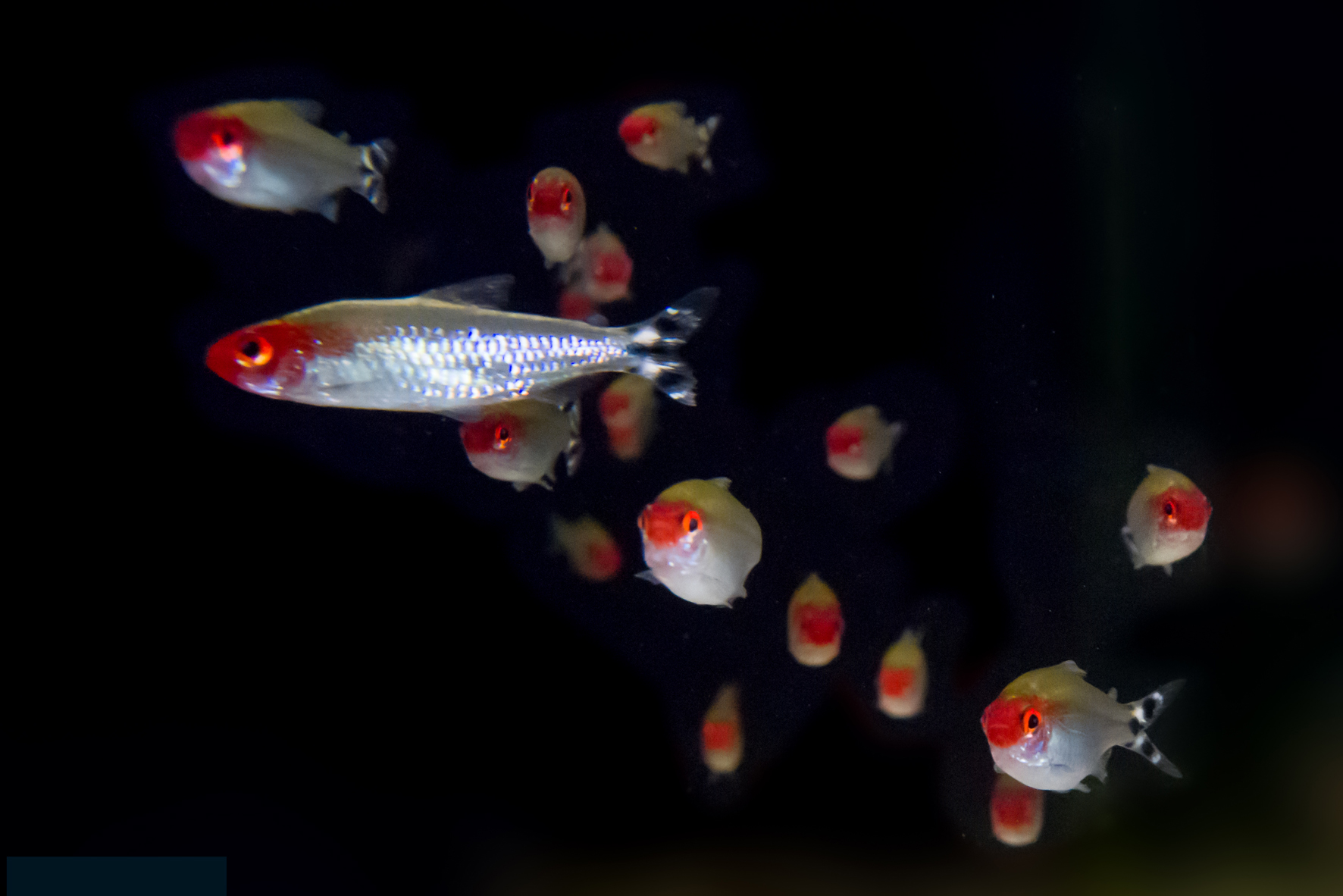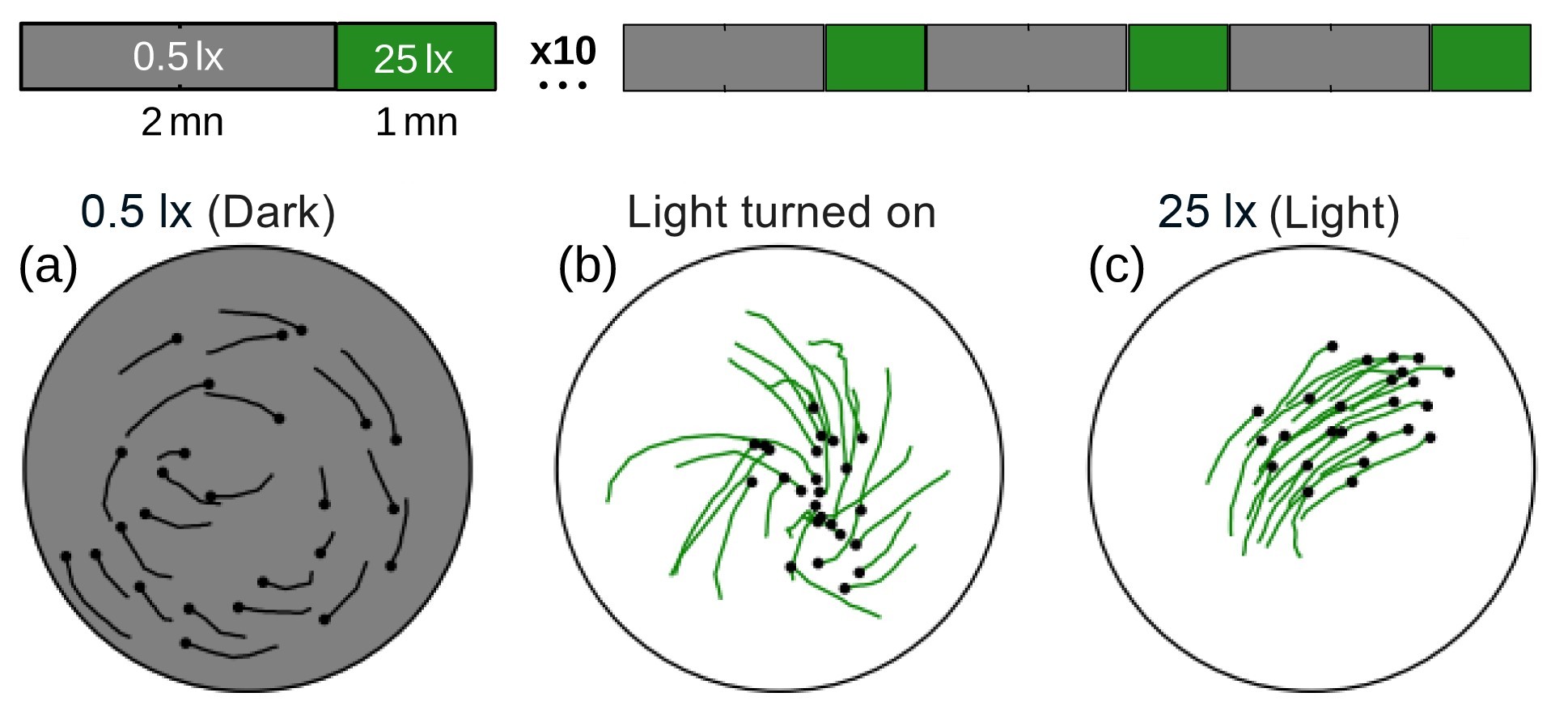How do groups of animals adjust their collective behavior when faced with sudden changes in their environment? A recent study by researchers from the team of Guy Theraulaz at the Center for Research on Animal Cognition, Clément Sire at the Laboratory of Theoretical Physics in Toulouse, and universities in China and India sheds light on this question. Published in PRX Life, their work focuses on schools of rummy-nose tetras and shows that when these fish experience environmental stress, they adjust how they interact with each other in ways that push the group toward a “critical” state—a condition known to boost sensitivity and responsiveness. The results help explain how animal groups can quickly adapt to changing conditions around them. See also the CNRS press release (in French).
 A key question in studying fish schools is how well they can respond to perturbations, whether from environmental shifts or predator attacks. To explore this, the researchers ran lab experiments in Toulouse using a tropical fish species known for its strong schooling behavior (Hemigrammus rhodostomus). Groups of these fish were exposed to sudden changes in light intensity, simulating moderate environmental stress (see Figure 1 and the video below). The team combined experimental data with a mathematical model that closely describes how fish swim in bursts and interact socially. This allowed them to map out the group behaviors in a “phase diagram,” showing distinct movement patterns: coordinated swimming in one direction, circular vortex motion, or disordered swarming (see Figure 2).
A key question in studying fish schools is how well they can respond to perturbations, whether from environmental shifts or predator attacks. To explore this, the researchers ran lab experiments in Toulouse using a tropical fish species known for its strong schooling behavior (Hemigrammus rhodostomus). Groups of these fish were exposed to sudden changes in light intensity, simulating moderate environmental stress (see Figure 1 and the video below). The team combined experimental data with a mathematical model that closely describes how fish swim in bursts and interact socially. This allowed them to map out the group behaviors in a “phase diagram,” showing distinct movement patterns: coordinated swimming in one direction, circular vortex motion, or disordered swarming (see Figure 2).
The results show that in large groups, stressed fish adjust the strength of their social interactions—such as attraction and alignment with others—to bring the group closer to a critical state (see Figure 2). In physics, this is the point where a system is most sensitive to a perturbation and ready to switch between different states. This behavior helps the school respond quickly to unexpected threats while staying organized. Surprisingly, smaller groups tend to stay near a critical state all the time, even without external stress. This suggests that in small groups, stress is constant—possibly because the calming effect of being surrounded by others is weaker when there are fewer neighbors.
It is remarkable that such collective adaptability arises from a simple underlying mechanism. Rather than changing the entire structure of social relationships within the group, each fish just adjusts how strongly it interacts with typically two neighbors. This keeps the cognitive load to a minimum.
These findings offer new insight into how social animals manage collective intelligence. They suggest that stress is not only a disruptive force—it can also drive group-level adaptability. In fish, both stress and group size appear to be key factors that help schools self-organize into critical states where they are most responsive and flexible.
Beyond fish schools, these results open up new ways of thinking about how other animal groups—from social insects to herd animals—adjust their behavior depending on the situation. They could even inspire the design of robotic systems, like swarms of autonomous drones that can automatically adapt their formation in unexpected conditions.

Figure 1. Collective behavior of a group of fish swimming in a circular tank under stress conditions. Each experiment includes 10 cycles, each lasting 3 minutes, alternating between low light intensity (darkness, 0.5 lx for 2 minutes) and high light intensity (light, 25 lx for 1 minute). (a) Snapshot of a group of 25 fish just before the increase in light intensity, (b) just after the light is turned on, and (c) 30 seconds later. Black dots represent the positions of the fish, while the black and green lines show individual trajectories during the last second.
 Figure 2. Within a fish school, attraction and alignment interactions between individuals lead to different forms of collective movement. Depending on the strength of these interactions, the group may form circular structures (Phase 1), move in a fully aligned direction (Phase 2), or display disordered motion (Phase 3). When exposed to environmental stress—such as a sudden increase in light intensity—the fish adjust their social interactions so that the school shifts into a state near the critical line separating two phases (shown in blue). This “critical” state gives the school both heightened sensitivity to perturbations and the ability to rapidly switch behaviors based on changes in the environment. Green crosses indicate the strength of attraction and alignment interactions between fish in darkness (left) and after a sudden increase in light intensity (right).
Figure 2. Within a fish school, attraction and alignment interactions between individuals lead to different forms of collective movement. Depending on the strength of these interactions, the group may form circular structures (Phase 1), move in a fully aligned direction (Phase 2), or display disordered motion (Phase 3). When exposed to environmental stress—such as a sudden increase in light intensity—the fish adjust their social interactions so that the school shifts into a state near the critical line separating two phases (shown in blue). This “critical” state gives the school both heightened sensitivity to perturbations and the ability to rapidly switch behaviors based on changes in the environment. Green crosses indicate the strength of attraction and alignment interactions between fish in darkness (left) and after a sudden increase in light intensity (right).
Reference: Lin, G., Li, X., Xue, T., Escobedo, R., Han, Z., Sire, C., Guttal, V. & Theraulaz, G. 2025. Experimental evidence of stress-induced critical state in schooling fish, PRX Life 3, 033018 (2025).
